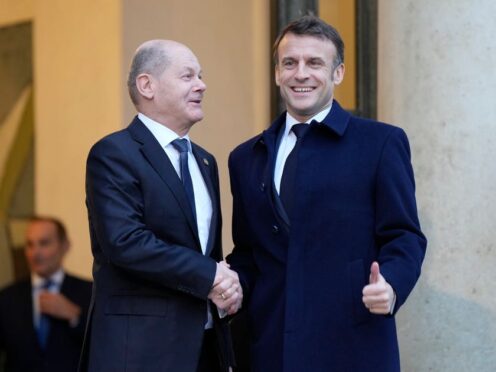European military heavyweights Germany and Poland affirmed on Tuesday that they will not be sending troops to Ukraine, after reports that some Western countries may be considering doing so as the war with Russia enters its third year.
The head of Nato also said the US-led military alliance has no plans to send troops to Ukraine, after other central European leaders confirmed that they too will not be providing soldiers.
The Kremlin, meanwhile, warned that direct conflict between Nato and Russia would be inevitable if the alliance sent combat troops.
“In this case, we need to talk not about probability, but about the inevitability (of conflict),” Kremlin spokesman Dmitry Peskov told reporters.
Moscow’s warning came a day after French President Emmanuel Macron said sending in Western ground troops should not be “ruled out” in the future, after hosting a conference of top officials from more than 20 of Ukraine’s Western backers.

German Chancellor Olaf Scholz appeared to have a different view of what happened in Paris.
He said the participants had agreed “that there will be no ground troops, no soldiers on Ukrainian soil who are sent there by European states or Nato states”.
He said there was also consensus “that soldiers operating in our countries also are not participating actively in the war themselves”.
The idea of sending troops has been taboo, particularly as Nato seeks to avoid being dragged into a wider war with nuclear-armed Russia.
Nato Secretary-General Jens Stoltenberg told the Associated Press: “Nato allies are providing unprecedented support to Ukraine. We have done that since 2014 and stepped up after the full-scale invasion. But there are no plans for Nato combat troops on the ground in Ukraine.”
At a meeting in Prague on Tuesday, Polish Prime Minister Donald Tusk said “Poland does not plan to send its troops to Ukraine.”
Prime Minister Petr Fiala has insisted “the Czech Republic certainly doesn’t want to send its soldiers”.
Slovakian Prime Minister Robert Fico has said his government is not planning to deploy, but that some countries are weighing whether to strike bilateral deals to provide troops to help Ukraine fend off the Russian invasion. He did not provide details about which countries or what troops would do in Ukraine.
Mr Macron, too, avoided naming any countries, saying he wanted to maintain “strategic ambiguity” and not tip the West’s hand to Russia.

Nato as an alliance provides Ukraine with only non-lethal aid and support like medical supplies, uniforms and winter equipment, but some members send weapons and ammunition bilaterally or in groups.
Any decision for the organisation to send troops would require unanimous support from all member countries.
A decision to send troops and keep them deployed long term would require the kind of transport and logistics capabilities that only countries like the US, UK, France, Germany and possibly Italy, Poland or Spain could muster.
While ruling out Nato military action, Mr Stoltenberg told the AP: “This is a war of aggression by Russia against Ukraine, blatantly violating international law. According to international law, Ukraine of course has the right to self-defence, and we have the right to support them in upholding that right.”
The conference in Paris took place after France, Germany and the UK each signed 10-year bilateral security agreements with Ukraine as Kyiv works to shore up Western support.
European nations fear the US will reduce its support, as aid for Kyiv is held up in Congress. They also have concerns that former president Donald Trump might return to the White House and change the course of US policy on the continent.
Several European countries, including France, expressed support on Monday for an initiative launched by the Czech Republic to buy ammunition shells for Ukraine outside the European Union, participants at the meeting said.
Mr Macron said a new coalition will be launched to deliver medium and long-range missiles.
In an interview last week, Mr Stoltenberg did not oppose the idea of allowing Ukraine to use Western weapons to strike targets in Russia. Some countries have placed restrictions on the use of materiel they provide, asking that it be used only inside Ukraine.
“It’s for each and every ally to decide whether there are some caveats on what they deliver,” Mr Stoltenberg told Radio Free Europe. But, he said, Ukraine’s right to self-defence “includes also striking legitimate military targets, Russian military targets, outside Ukraine”.
